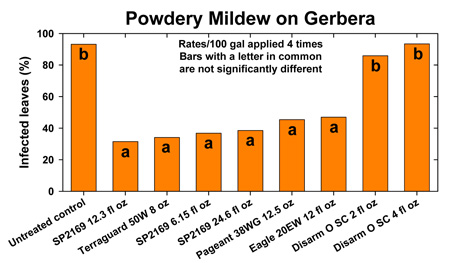Greenhouse disease update for Powdery mildew
Editor’s note: This article is from the archives of the MSU Crop Advisory Team Alerts. Check the label of any pesticide referenced to ensure your use is included.
Powdery mildew is a common and difficult problem if not managed effectively. Powdery mildew can occur on all above-ground plant parts and results in white growth on the plant’s surface. When the fungus reproduces, the abundant conidia (spores) give a white, powdery or fluffy appearance. Severe infection can cause yellowing and withering of leaves and restrict plant growth. Powdery mildew can infect plants even when the relative humidity is low, but epidemics are prompted when relative humidity is high. Sometimes the powdery mildew progresses unnoticed until many plants are infected. Powdery mildew is well known for its ability to adapt and develop resistance to fungicides, and it is important to rotate among fungicides with different modes of action. Using as few sprays as possible also helps to delay the development of resistance. Usually, powdery mildew is best controlled when fungicides are begun prior to the appearance of the disease.With especially susceptible crops, it would likely be of benefit to begin a spray program prior to disease development and apply systemic fungicides (alternate products) effective against powdery mildew at two to three week intervals (depending on product used, crop susceptibility, and environment) to maintain a healthy crop.
Evaluation of curative applications of registered and unregistered fungicides to control powdery mildew on gerbera daisies, 2009
Disease pressure was severe at the initial application on June 29 with all plants having approximately 70 percent of leaves infected with powdery mildew. The level of infection peaked on August 10 with the untreated plants averaging 97.5 percent foliage with powdery mildew. All treatments with the exception of Disarm O (both rates) limited infection compared to the untreated control. A rate response was not observed with the experimental SP2169 treatments with all rates limiting infection to less than or equal to 38.5 percent on the final rating date. Newly registered product Pageant WG limited infection comparable to industry standards Eagle EW and Terraguard 50W.No phytotoxicity was observed on any of the treated plants in this trial.


Acknowledgements
This research was funded in part by Floriculture Nursery and Research Initiative of the Agricultural Research Service under Cooperative Agreement #59-1907-5-553 and by the American Floral Endowment.




 Print
Print Email
Email


